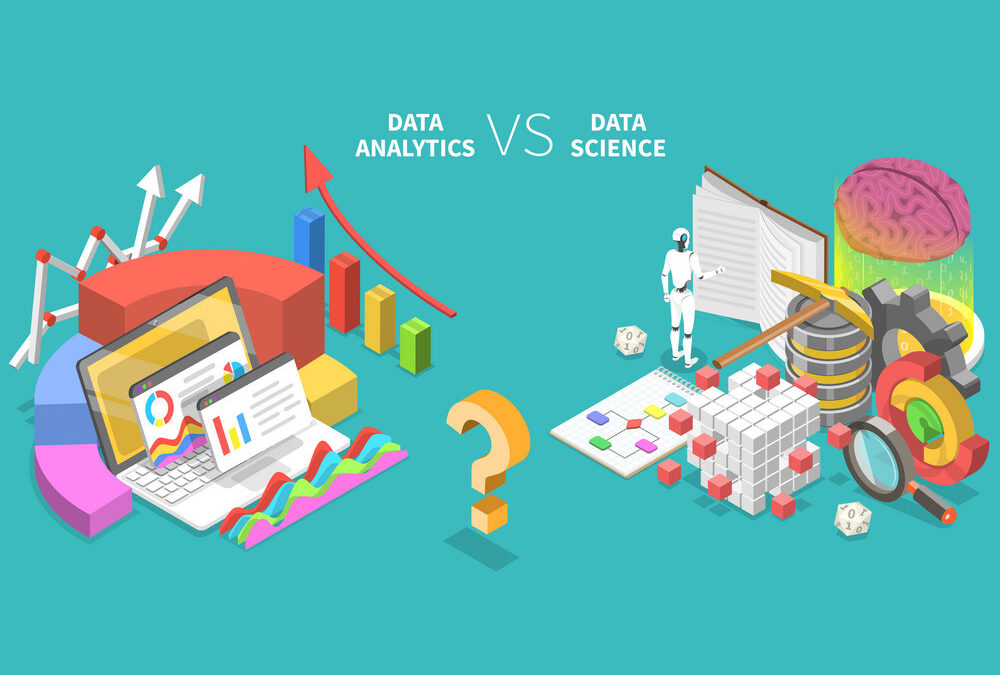
Data Science and Analytics: Shaping the Future of Decision-Making
- Artificial Intelligence (AI) and Machine Learning (ML) Integration:
As we move into the future, AI and ML will continue to play a central role in data science and analytics. These technologies enable automated data processing, pattern recognition, and predictive modelling, leading to enhanced insights and efficiency. AI-powered algorithms will become more sophisticated, enabling deeper analysis of complex data sets and driving decision-making across industries.
- Augmented Analytics:
Augmented analytics is an emerging trend that combines AI, ML, and natural language processing (NLP) to enhance the analytical capabilities of data scientists and business users. It enables users to leverage intuitive tools to interact with data, extract meaningful insights, and make data-driven decisions without requiring extensive technical expertise. The future will see augmented analytics platforms becoming more accessible and democratized, empowering a broader range of users to derive value from data.
- Internet of Things (IoT) and Sensor Data:
The proliferation of IoT devices and the collection of massive amounts of sensor data present new opportunities for data science and analytics. As more devices become interconnected, data scientists will need to leverage advanced techniques to extract actionable insights from IoT-generated data streams. Real-time analysis, anomaly detection, and predictive maintenance will become crucial in various sectors, including manufacturing, healthcare, transportation, and smart cities.
- Ethical Considerations:
With the increased reliance on data and algorithms, ethical considerations will become more important in the future of data science. Privacy, bias, and transparency will be critical concerns. Organizations will need to establish robust governance frameworks to ensure responsible data collection, use, and decision-making. Data scientists and analysts will play a pivotal role in addressing these ethical challenges and ensuring that data-driven innovations benefit society as a whole.
- Advanced Visualization and Storytelling:
Data visualization has already proven its effectiveness in conveying insights and aiding decision-making. In the future, data scientists will leverage advanced visualization techniques, such as virtual reality (VR) and augmented reality (AR), to create immersive experiences that facilitate deeper understanding and exploration of complex data sets. Interactive dashboards, 3D visualizations, and data-driven storytelling will become powerful tools for communicating insights and driving action.
- Prescriptive Analytics:
While descriptive and predictive analytics have been widely adopted, prescriptive analytics will gain prominence in the future. Prescriptive analytics goes beyond predicting outcomes by suggesting the best course of action to achieve desired outcomes. By combining historical data, real-time information, and optimization algorithms, prescriptive analytics will enable organizations to make data-driven decisions with a higher degree of confidence, enhancing efficiency and competitiveness.
- Data Science Automation:
Automation will continue to transform the field of data science and analytics. As data volumes grow, data scientists will increasingly rely on automated processes for data cleansing, feature engineering, model selection, and deployment. Automated machine learning (AutoML) tools will streamline the model development process, making data science more accessible to non-experts and accelerating innovation.
Future of Data Analysis
The scope of data science and analysis is expanding rapidly and is expected to continue growing in the future. Data science involves extracting knowledge and insights from large and complex datasets through various techniques such as statistical analysis, machine learning, and data visualization. It plays a crucial role in decision-making processes across industries.
In terms of future job prospects, data science and analysis offer a wide range of opportunities. Companies in sectors like finance, healthcare, retail, marketing, and technology heavily rely on data-driven insights to gain a competitive edge. As more organizations recognize the value of data, the demand for skilled data scientists and analysts is expected to increase.
Roles in data science and analysis include data scientists, data analysts, machine learning engineers, business intelligence analysts, and data engineers. These professionals are responsible for collecting, cleaning, and analyzing data to uncover patterns, make predictions, and provide actionable recommendations.
In addition to traditional job roles, emerging fields within data science, such as big data analytics, natural language processing, computer vision, and artificial intelligence, are gaining prominence. These fields present exciting opportunities for those with expertise in advanced analytics techniques and specialized domains.
To excel in data science and analysis, individuals should possess a strong foundation in mathematics, statistics, programming, and problem-solving. They should also be proficient in utilizing tools and technologies like Python, R, SQL, and various data visualization platforms.
Overall, the future of data science and analysis is promising, with a wide range of career prospects across industries as organizations increasingly rely on data to drive their decision-making processes.
REAL LIFE EXAMPLES OF SUCCESSFUL DATA SCIENCE AND ANALYSIS.
There are several companies that have been successful in leveraging data science and analysis to drive their business strategies and achieve significant outcomes. Here are a few notable examples:
- Google
Google is renowned for its extensive use of data analytics to improve its search engine algorithms, personalize user experiences, and optimize advertising campaigns. They utilize data science techniques to analyze vast amounts of data and provide relevant and accurate search results. - Amazon:
Amazon heavily relies on data science and analysis for various aspects of its business, including personalized product recommendations, supply chain optimization, fraud detection, and forecasting customer demand. Their data-driven approach has contributed to their success in e-commerce and cloud services. - Netflix:
Netflix is a prime example of a company that leverages data science to provide personalized recommendations and improve content discovery. They analyze user viewing patterns and preferences to make informed decisions about content production, acquisition, and recommendations, enhancing the user experience. - Uber:
Uber uses data science and analysis for various purposes, including dynamic pricing, route optimization, driver allocation, and demand forecasting. They collect and analyze data from multiple sources, such as GPS, user feedback, and historical trip data, to continuously improve their operations and provide efficient transportation services. - Facebook:
Facebook utilizes data science extensively to personalize user feeds, target advertisements, detect and prevent fraud, and improve user engagement. They analyze user behavior and interactions to provide relevant content and optimize their advertising platform.
Conclusion:
The future of data science and analytics is full of exciting possibilities. As AI, ML, IoT, and advanced visualization technologies continue to evolve, organizations will harness the power of data to drive innovation, optimize operations, and gain a competitive edge. However, it is essential to navigate ethical considerations and ensure responsible use of data to build a future that benefits all.
FAQs on Data Science and Analytics:
Q: What skills are important in data science and analytics?
A: Important skills in data science and analytics include programming (Python, R, SQL), statistical analysis, machine learning, data visualization, problem-solving, and domain knowledge.
Q: What is the role of machine learning in data science and analytics?
A: Machine learning is a subset of artificial intelligence that enables computers to learn from data without being explicitly programmed. It plays a crucial role in data science and analytics by building predictive models and making sense of large volumes of data.
Q: What are some common tools and technologies used in data science and analytics?
A: Common tools and technologies used in data science and analytics include Python (with libraries such as NumPy, Pandas, and Scikit-learn), R, SQL, Tableau, Apache Hadoop, Apache Spark, and TensorFlow.
Q: How is data science used in business?
A: Data science is used in business to drive data-driven decision-making, optimize processes, improve customer experience, identify patterns and trends, perform market analysis, and gain a competitive edge by leveraging insights from data.
Q: What are some challenges in data science and analytics?
A: Challenges in data science and analytics include data quality and pre-processing, handling large volumes of data (big data), model selection and validation, interpretability of complex models, privacy and ethical considerations, and staying updated with evolving techniques and technologies.
Q: What is the difference between data science and data analytics?
A: While there is some overlap between the two terms, data science is a broader field that encompasses data analytics. Data analytics focuses on analyzing data to uncover insights and make informed decisions, while data science includes analytics as well as other aspects like data acquisition, pre-processing, and building predictive models.
Q: What are some real-world applications of data science and analytics?
A: Real-world applications of data science and analytics include fraud detection, recommendation systems, predictive maintenance, customer segmentation, sentiment analysis, supply chain optimization, healthcare analytics, and financial forecasting.
Q: How is data science and analytics impacting various industries?
A: Data science and analytics are having a significant impact across industries. They are driving improvements in healthcare outcomes, helping businesses make data-driven decisions, enabling personalized marketing and customer experiences, optimizing manufacturing processes, and enhancing cybersecurity, among many other applications.

